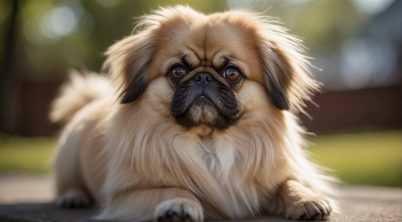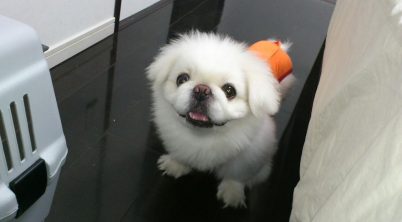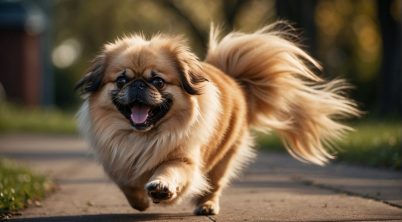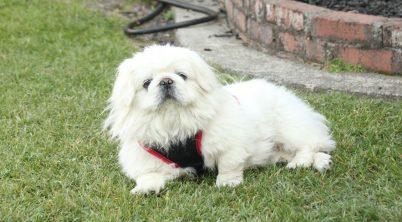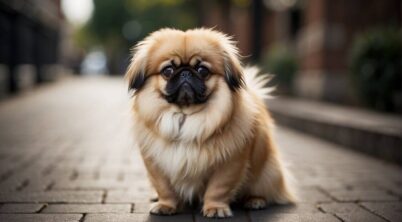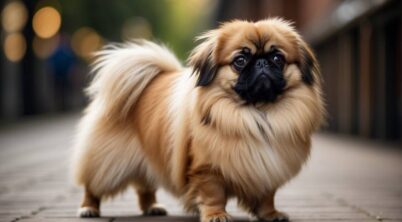The Pekingese is an ancient toy dog breed with a compelling history that can be traced back to the imperial courts of China. Known for its small size, the Pekingese boasts a confident and regal demeanor, reflecting its storied past as a favored pet among Chinese royalty. Originating in the city of Beijing (historically known as Peking), this breed has been a symbol of prestige and luxury, closely associated with the ruling classes since its inception.
Characterized by their loyal and independent nature, Pekingese dogs have a distinct personality that sets them apart from many other breeds. Despite their small stature, they carry themselves with an aristocratic air, often described as aloof or dignified. With their long, flowing coats and lion-like mane, they exude an air of elegance befitting their imperial heritage.
As a family companion, the Pekingese is well-suited to a life of indoor leisure and is commonly seen as an ideal lapdog. Their affectionate demeanor makes them fond of their human companions, though their independent streak can require a level of respect for their space. Compact and charming, the Pekingese remains a beloved breed for those looking to have a small, yet spirited member as part of their household.
Table of Contents
Pekingese as Mountain Dog
The Pekingese, while a breed of regal origin and distinct appearances, is not typically categorized as a mountain dog. These small, compact canines possess a physical build and temperament that differ significantly from dogs traditionally associated with mountainous environments, such as the Bernese Mountain Dog.
Physical Characteristics:
- Size: Pekingese are small dogs, often weighing between 7 to 14 pounds.
- Build: They have a stocky and somewhat robust body for their size, but are not designed for rugged terrains.
Temperament and Exercise Needs:
- The breed is known for a less active lifestyle, suitable for indoor living.
- Pekingese do not require the same level of exercise as typical mountain breeds. A short walk or playtime is adequate for their needs.
Climate Consideration:
- Pekingese have a double coat, which provides some insulation.
- However, they are not adapted to handle extremes in temperature, particularly the heat, due to their brachycephalic (shortened) face.
Health Considerations:
- Pekingese would not thrive on the strenuous activities expected of a mountain dog.
- Elevated terrains and rigorous physical demands would pose a health risk, particularly to their respiratory system.
In summary, the Pekingese breed does not possess the traits of a mountain dog. Their size, exercise needs, and physical design make them more suited to a comfortable indoor environment than the challenging conditions of mountainous regions.
Breed Overview
The Pekingese is a toy breed with a storied history originating from ancient China. It is known for its distinctive physical traits and a demeanor reflecting its heritage as a favored companion of Chinese royalty.
Physical Characteristics
Height and Weight: The Pekingese stands about 6-8 inches tall at the shoulder and generally weighs up to 14 pounds. Dogs exceeding the weight limit of 14 pounds are disqualified from American Kennel Club conformation shows.
Body: They possess a compact, stocky body contributing to a unique, rolling gait.
Coat: The coat of the Pekingese is long, dense, and comes in various colors, including red, white, fawn, black and tan, cream, sable, gray, and gold. The breed’s fur is known for its lushness and requires regular grooming due to its density and the feathering around the ears, tail, and legs.
Head: Their distinctive appearance features a short, snout indicative of their brachycephalic nature, with large, expressive eyes and a characteristic V-shaped facial wrinkle.
Temperament: Pekingese are loyal, affectionate, and have an independent streak that can sometimes be perceived as stubborn. Their regal origins are reflected in a confident and aloof attitude, and they can be both protective and sophisticated, making them discerning family pets.
Health and Care
Proper health and care are crucial for the well-being of Pekingese dogs. They demand consistent grooming due to their long, coarse, double coat. Regular brushing—several times a week—is advised to prevent matting and to manage shedding. Beyond brushing, their grooming routine should include the occasional bath and trimming around the feet and rear end for hygiene.
When addressing the exercise needs of a Pekingese, consider their low energy level. Their characteristic rolling gait doesn’t predispose them to vigorous exercise. However, to maintain good health, a regimen of short walks or play sessions, totaling around 40 minutes per day, helps mitigate risks of obesity, a common issue among this breed.
Diet and nutrition are critical. Pekingese dogs should be fed high-quality food that’s appropriate to their stage in life, whether puppy, adult, or senior. It’s important to monitor their food intake carefully to ensure they’re getting balanced nutrition without excess calories that can lead to weight gain.
Given their brachycephalic nature, Pekingese are prone to breathing issues; thus, moderate weather and controlled exercise are important. Additionally, pay attention to their eyes, as the breed can suffer from eye problems due to their facial structure.
Regular veterinarian visits, including vaccinations and dental care, are key to catching and managing any health problems early. Potential owners should seek Pekingese from reputable breeders or consider adoption from shelters. Always look for signs of good health, and discuss care routines with those experienced in the Pekingese breed.
Maintaining their lifestyle requires a commitment to their particular needs, but with comprehensive care, Pekingese dogs can enjoy a fulfilling life as a beloved family companion.
Training and Behavior
Training a Pekingese requires an understanding of their unique personality and behavioral traits. These dogs are known for being affectionate with their families but can exhibit a stubborn streak, which makes consistent, rewards-based training imperative.
Personality and Temperament:
- Pekingese dogs are known for their lion-like appearance and noble bearing.
- They are affectionate and form strong bonds with family members.
- Often described as alert and protective, they can be excellent watchdogs.
Trainability and Exercise:
- Despite their intelligence, Pekingese are not the easiest breed to train due to their independent nature.
- A patient and consistent approach to training works best, avoiding negative reinforcements.
- Rewards-based training is effective, reinforcing positive behavior with treats or praise.
- They require moderate exercise to remain healthy and happy; however, they are not highly energetic dogs.
Socialization:
- Early socialization helps mitigate their tendency towards being reserved or slightly aggressive with strangers and other pets.
- Introducing them to various environments and people can help them become more tolerant and well-adjusted.
Living with Families:
- Pekingese can be wonderful family pets when socialized properly.
- Caution is advised around toddlers as Pekingese might not tolerate rough play.
- They usually coexist peacefully with other family pets when introduced appropriately.
It’s important for potential Pekingese owners to understand that while these dogs are intelligent, their independent nature can challenge training. An approach that incorporates affection, firmness, and positive reinforcement is likely to yield the best results. Due to their watchdog capabilities, Pekingese are vigilant and will bark to alert their family of any perceived threats, making them reliable sleeve dogs. Their size and temperament also make them suitable for both apartment living and homes with yards.
Living with a Pekingese
Pekingese dogs are compact, affectionate companions well-suited for various living environments, including apartments. Their manageable size and moderate exercise requirements make them ideal for city living. However, they do crave attention and enjoy being family pets, bonding closely with their owners.
When it comes to lifestyle, Pekingese have an independent nature, but they also possess an endearing quality as lapdogs. Despite their small stature, they often carry themselves with a noble dignity that echoes their history of being bred as companions for Chinese emperors.
Exercise Needs:
- Daily Walks: One or two short daily walks suffice.
- Playtime: Engage them in play to keep their energy levels balanced.
Grooming Requirements:
- Coat Care: Brush weekly to prevent matting.
- Bathing: Regular baths maintain coat health.
- Professional Grooming: Optional but can help with maintenance.
Nutrition:
- Diet: Balanced diet with controlled portions to prevent obesity.
- Hydration: Fresh water should always be available.
Pekingese are also noted for their adaptability. They can thrive in homes with or without yards, as they don’t require extensive outdoor space for exercise. As for their social nature, they are generally tolerant but may exhibit reservation around strangers, so early socialization is key.
In terms of care, proactive attention to their health is important due to potential breed-specific issues. Ensure regular veterinary check-ups to maintain their well-being. Pekingese make loving family pets, displaying loyalty and companionship when raised with consistent care and affection.
Resources and Further Reading
When seeking comprehensive information on the Pekingese breed, there are numerous resources available for owners and enthusiasts. These resources range from informative books and guides to vibrant online communities, and they offer insights from experts and veterinarians, fostering a deeper understanding of the breed.
Books and Guides
- Books:
- The Complete Pekingese by Milo G. Denlinger – A classic breed handbook that covers history, care, and behavior.
- Pekingese: A Comprehensive Guide to Owning and Caring for Your Dog from the Kennel Club Books series – Detailed care instructions tailored to the Pekingese breed.
- Guides:
- Pekingese 101: Owner’s Guide – Offers step-by-step advice on health, training, and obedience.
Online Communities
- Forums and Social Media Groups:
- Pekinews – Online Pekingese Community – A forum dedicated to Pekingese care and ownership where enthusiasts can exchange tips.
- Facebook and Instagram have breed-specific pages and groups where members share experiences and organize meetups.
Experts and Veterinarian Insights
- Veterinarian Advice:
- Regular consultations with a veterinarian familiar with brachycephalic breeds like the Pekingese can provide indispensable healthcare tips.
- Breed Specialists and Trainer Recommendations:
- Engaging with breed specialists and experienced trainers can offer behavior and care guidance specific to the Pekingese’s unique needs.


